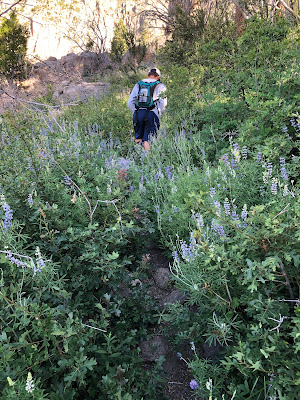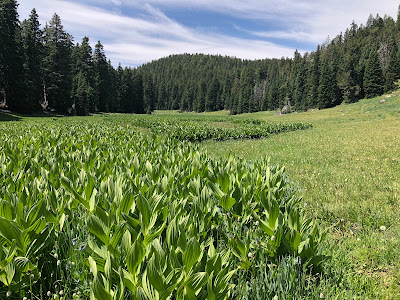 try the Das Boot route of the Subway, which adds about 1.5 miles (and 2 hours) to the hike. The Das Boot section is also a bit more technical in places and the water is much more frigid due to the narrow canyons where light rarely, if ever, penetrates to the floor. (An additional permit is required in addition to the Subway permit, for Das Boot)
try the Das Boot route of the Subway, which adds about 1.5 miles (and 2 hours) to the hike. The Das Boot section is also a bit more technical in places and the water is much more frigid due to the narrow canyons where light rarely, if ever, penetrates to the floor. (An additional permit is required in addition to the Subway permit, for Das Boot)We met at the Lin’s in Hurricane and carpooled in 3 cars to our first destination – the Left Fork Trailhead. To get there, head to the town of Virgin on SR-9 and go north on Kolob Terrace Road toward the Kolob Reservoir. After about 9 miles, there will be a sign indicating the Left Fork Trailhead off to the right.
 We left 2 cars here and all piled into the 3rd, heading further up the road about another 7 miles to the Wild Cat Canyon Trailhead. Again, another sign marks the turnoff to the right.
We left 2 cars here and all piled into the 3rd, heading further up the road about another 7 miles to the Wild Cat Canyon Trailhead. Again, another sign marks the turnoff to the right.We arrived at the trail head a little before 8:00 and hit the trail at 8:05. There were 9 of us that started out the hike. The original plan was for the 3 more novice hikers to go the regular Subway route and the other 6 hikers to go the Das Boot route. We would then meet up at the normal Subway entrance as is required by Zion National Park (no splitting up when a permit has been issued).
You start by following the Wildcat Canyon trail for about 1 mile. The trail starts off in a high-desert setting but quickl
 y becomes more and more dotted with pine trees. After 1 mile, you’ll encounter the Northgate Peaks Trail junction. Turn right onto the Northgate peaks junction and follow it for about 200 yards until you see a sign indicating the “Left fork of North Creek” and the “Subway”.
y becomes more and more dotted with pine trees. After 1 mile, you’ll encounter the Northgate Peaks Trail junction. Turn right onto the Northgate peaks junction and follow it for about 200 yards until you see a sign indicating the “Left fork of North Creek” and the “Subway”.Shortly after this turnoff, the trail leads you to slickrock. Up to this point the trail is very well defined. Once on the slickrock, I expected to see cairns marking the route, but there was only 1 that I saw the whole first section. But we managed to spot the trail off in the distance though, as the slickrock gave way to a forested area again.
After about .5 of a mile, we left the trail off to the left to cross over Russell Gulch before it became more difficult. We actually crossed right before it became a canyon. After crossing we looked back and noticed a more defined trail that we had somehow missed. Once on the east side of Russell Gulch, begin climbing up the slickrock to the main ledge. Once on the ledge continue about another .5 miles. At this point, you can begin to see the canyon that makes up the Subway.

Once there is a substantial ridge to your right, descend toward the canyon and route find your way into Das Boot. There are very few entry points. The one we used was a small drainage which required a bit of down climbing to get into and then a little bit of down climbing to get from it to Das Boot.
Shortly after our entry, the canyon walls narrowed as if to welcome us to our challenge. We started through the beautiful canyon along the dry river bed, coming to a few small obstacles every now and then. After a short time, we encountered our first technical section - a dry waterfall which had about a 12 foot drop. Apparently, a log used to make this obstacle a mere catwalk, but the log had been broken so the only
 way down was a drop. We got out the daisy chains and one by one lowered ourselves down – some more gracefully than others. Looking back on it, we could have all hung on the log and then dropped a short distance to the bottom, as Jason did, who unclipped the daisy chains and came down on his own. But we’ll chalk that up to it being the first obstacle of the day.
way down was a drop. We got out the daisy chains and one by one lowered ourselves down – some more gracefully than others. Looking back on it, we could have all hung on the log and then dropped a short distance to the bottom, as Jason did, who unclipped the daisy chains and came down on his own. But we’ll chalk that up to it being the first obstacle of the day.Shortly after our first technical section came the water. For the most part, we were only in up to our knees and occasionally our waist. Nick had mentioned that the water is normally much higher than it was. We did have one short swim of about 15 feet which kept me chilled for the next few hours.

The final obstacle we came to was about a 25 foot drop into a shallow pool (maybe 6 feet). After trying to figure out an easy way down, the group decided to get out the ropes and harnesses to repel down. I continued to look for a good down climb and found one off to the right. The dicey part was getting off of the main ledge to one about 5 feet below it which was only about 2 feet wide. I decided to go over the edge on my stomach which meant I couldn’t tell when/if my feet were about to hit the ledge – a scary feeling. Once onto the ledge it was a pretty easy down climb, albeit on very narrow ledges. The others in the group still elected to repel down after seeing that I had made it to the bottom.

This brought us to the entry point of the Subway. We arrived at about 11:15 and expected to see the other 3 members of our group waiting for us. But they weren’t there as we had expected and, after waiting for about 20 minutes, Nick decided to go up the trail a bit to look for them. He discovered that two of the others had turned back because of some steepness which was taking a toll on one of their knees.
We resumed our hike at about 12:00 and were now on our way to the subway. Not too long after we had started back up we came to another swimming hole. This swim was a little longer – maybe 25 feet. The water was much warmer in the standard subway route than it was in the Das Boot section, but still left me scurrying to find sunlight penetrating the canyon walls to warm my self up.

Just before entering the actual “subway” and about 1.5 miles from the Russell Gulch/North Fork Junction, we encountered Keyhole Falls. Many people down climbed this obstacle without much trouble. I was still shivering from my previous swims and down climbing would have meant that I would have to wade through chest deep water once again so I decided to repel (hand over hand) past the wading part and stay dry.
Once past Keyhole falls, the amazing beauty of the subway begins. Corridors are filled with pools of water of all kinds of interesting shapes – one even resembling a heart. Despite the many people that were there, I was still left feeling that I was discovering something incredible on my own.

Just out of the subway are the red ledges, a very beautiful series of small waterfalls over slickrock. Walking out of the subway and towards the red ledges gives the feeling of walking off the end of the earth, as the water flows over the edge, but what is over the edge can’t be seen.
We carefully made our way down the red ledges (very slippery) making sure to keep our weight slightly forward so as not to have the misfortune of ending up on our backsides.
About 1.5 miles out of the subway, there are some very distinct dinosaur tracks on large blocks of light grey mudstone located about 15 feet to the right of the river. They are hard to miss unless you are hiking with your head down trying to keep your footing in the water.
By this time the canyon walls have opened up. About 1 mile from the dinosaur tracks is the exit back to “Left Fork Trailhead” as marked on the signs. The ascent north is difficult, especially after the long hike negotiating obstacles and slickrock. Fortunately it is only about .1 of a mile and covers 400 vertical feet.

Once to the top, it is another .5 mile stroll to the parking lot. There are a few little trails that break off. For the most part, if you just stay on the main trail, which is to the left, you’ll make it back.
We made it back to the parking lot at 4:45 – an 8 hour 40 minute adventure. We hiked at a very slow pace, took tons of pictures and had many rest stops so the actual time for most people would probably be about 1 hour less than that.
















%5B1%5D.jpg)
%5B1%5D.jpg)












































